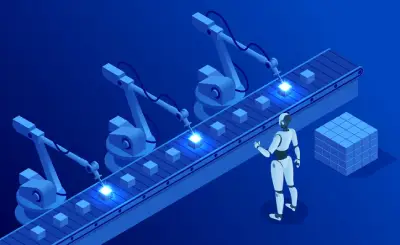

AI Innovations in Electrical Automation
Catalog
Protection and Control Functions in Electrical Automation SystemsDiagnosis of Electrical FaultsEnhancing the Effectiveness of Electrical ControlImproving Electrical Equipment DesignProtection and Control Functions in Electrical Automation Systems
Currently, the application of artificial intelligence technology enables the automation and real-time dynamic processing and collection of analog and digital data. Based on the system design requirements, data is systematically stored and organized in batches. Additionally, image generation software is used to simulate the actual operation of the electrical automation system. This allows staff to visually observe changes in devices and parameters such as circuit breakers, isolating switches, voltage, and current. Staff can create professional charts and analyze relevant data according to the system's operational requirements. It is important to note that since images and screens can consume significant system resources, the operational performance of the control terminal equipment and the software system requirements must be carefully considered to avoid excessive resource consumption and impact on the normal operation of other programs within the electrical automation system. Moreover, for operational control, staff can remotely control circuit breakers and isolating switches via mouse or keyboard, automatically adjust excitation currents, and modify or set online parameters to enhance the reliability and stability of the electrical automation system.

Diagnosis of Electrical Faults
In the practical operation of electrical automation systems, traditional diagnostic techniques often lack efficiency and accuracy, and faults frequently occur in equipment such as transformers, generators, and engines. Previously, staff would analyze transformer oil gases to determine faults, a method that is time-consuming and labor-intensive with poor timeliness. Many faults and accidents in electrical automation systems are uncertain and sudden, requiring quick resolution to avoid significant losses to the country, society, and enterprises. By applying artificial intelligence technology within electrical automation systems, using expert systems, fuzzy theory, and neural networks, real-time control and fault diagnosis can be achieved. This significantly improves the efficiency and accuracy of diagnosing faults in electrical automation systems.
Enhancing the Effectiveness of Electrical Control
Artificial intelligence technology plays a crucial role in electrical control. Ensuring the safe and stable operation of electrical control systems is a major challenge for many companies. Electrical control demands high standards and precision from operators, and the specific control procedures can be complex and cumbersome. Consequently, experts and scholars in China have been dedicated to continuously improving the operational control levels of electrical control systems.
In electrical control, artificial intelligence technology leverages automation and computer systems to perform certain tasks, minimizing human error and greatly enhancing control accuracy. Additionally, AI technology simplifies electrical system operations and control processes through intuitive, user-friendly interfaces. It enables remote control operations of certain system components via computer networks. Furthermore, AI technology allows for real-time storage of critical data and information, making future inquiries more convenient. AI can automatically generate reports, reducing the investment in financial, material, and human resources, and effectively improving the precision and efficiency of electrical control systems.
AI applications in electrical control systems include fuzzy control, neural network control, and expert system control. For instance, fuzzy control is used for both AC and DC drives in electrical control systems, replacing traditional speed controllers to ensure accuracy.
Improving Electrical Equipment Design
Electrical equipment design is a specialized and complex task. Designers need to be proficient in motor electronics, electromagnetic fields, circuits, and accumulate substantial experience in electrical design. Traditional design methods involve manually creating designs in a laboratory based on specific requirements. Once the equipment is manufactured, modifications or optimizations are challenging, complicating maintenance and making it difficult to achieve the best design solutions.
With the rapid advancement of computer technology, manual design is no longer sufficient for the evolving demands of electrical systems. AI technology aids in design through computer-assisted tools, such as 2D and 3D CAD, allowing for real-time modifications and optimizations based on design requirements, thus significantly shortening product development cycles. Additionally, genetic algorithms used in electrical equipment design help optimize performance. Since electrical equipment faults exhibit non-linearity and uncertainty, AI technology can establish relationships between equipment faults and operational states, enhancing the design level of electrical equipment.
In recent years, the rapid development of computational software technology and microelectronics has greatly advanced artificial intelligence technology, which is now widely used across various fields. In electrical automation, the application of AI technology leverages its many advantages to significantly enhance the safety and reliability of system operations.
The future development of artificial intelligence, big data, cloud computing, and the Internet of Things is noteworthy, as these are all cutting-edge industries. The era of multiple intelligences focuses on introducing and popularizing AI and big data.
Subscribe to JMChip Electronics !



















